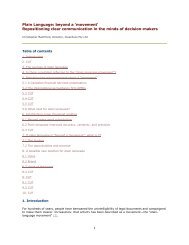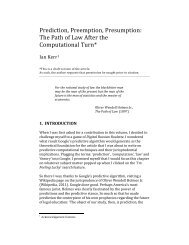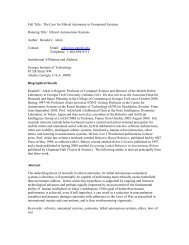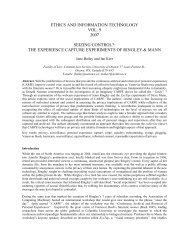'Asimov's Laws of Robotics' - the Laws of Robotics 2013
'Asimov's Laws of Robotics' - the Laws of Robotics 2013
'Asimov's Laws of Robotics' - the Laws of Robotics 2013
- No tags were found...
You also want an ePaper? Increase the reach of your titles
YUMPU automatically turns print PDFs into web optimized ePapers that Google loves.
Roger Clarke's <strong>'Asimov's</strong> <strong>Laws</strong> <strong>of</strong> <strong><strong>Robotics</strong>'</strong><strong>2013</strong>-09-03 10:33 AMNonhumaniforms, such as conventional industrial robots and large, highly dispersed robotic systems (such aswarehouse managers. ATMs, and EFT/POS systems) seem less likely to elicit such warmth. Yet severalstudies have found a surprising degree <strong>of</strong> identification by humans with computers. 17,18 Thus, some hi<strong>the</strong>rtoexclusively human characteristics are being associated with computer systems that don't even exhibit typicalrobotic capabilities.Users must be continually reminded that <strong>the</strong> capabilities <strong>of</strong> hardware/s<strong>of</strong>tware components are limited:<strong>the</strong>y contain many inherent assumptions;<strong>the</strong>y are not flexible enough to cope with all <strong>of</strong> <strong>the</strong> manifold exceptions that inevitably arise; and<strong>the</strong>y do not adapt to changes in <strong>the</strong>ir environment;authority is not vested in hardware/ s<strong>of</strong>tware components but ra<strong>the</strong>r in <strong>the</strong> individuals who use <strong>the</strong>m.Educational institutions and staff training programs must identify <strong>the</strong>se limitations; yet even this is notsufficient: The human- machine interface must reflect <strong>the</strong>m. Systems must be designed so that users arerequired to continually exercise <strong>the</strong>ir own expertise, and system output should not be phrased in a way thatimplies unwarranted authority. These objectives challenge <strong>the</strong> conventional outlook <strong>of</strong> system designers.Human opposition to robotsRobots are agents <strong>of</strong> change and <strong>the</strong>refore potentially upsetting to those with vested interests. Of all <strong>the</strong>machines so far invented or conceived <strong>of</strong>, robots represent <strong>the</strong> most direct challenge to humans. Vociferousand even violent campaigns against robotics should not be surprising. Beyond concerns <strong>of</strong> self interest is <strong>the</strong>possibility that some humans could be revulsed by robots, particularly those with humanoid characteristics.Some opponents may be mollified as robotic behavior becomes more tactful. Ano<strong>the</strong>r tenable argument isthat by creating and deploying artifacts that are in some ways superior. humans degrade <strong>the</strong>mselves.System designers must anticipate a variety <strong>of</strong> negative reactions against <strong>the</strong>ir creations from different groups<strong>of</strong> stakeholders. Much will depend on <strong>the</strong> number and power <strong>of</strong> <strong>the</strong> people who feel threatened - and on <strong>the</strong>scope <strong>of</strong> <strong>the</strong> change <strong>the</strong>y anticipate. If, as Asimov speculates, 9 a robot- based economy develops withoutequitable adjustments, <strong>the</strong> backlash could be considerable.Such a rejection could involve powerful institutions as well as individuals. In one Asimov story, <strong>the</strong> USDepartment <strong>of</strong> Defense suppresses a project intended to produce <strong>the</strong> perfect robot- soldier. It reasons that <strong>the</strong>degree <strong>of</strong> discretion and autonomy needed for battlefield performance would tend to make robots rebelliousin o<strong>the</strong>r circumstances (particularly during peace time) and unprepared to suffer <strong>the</strong>ir commanders' foolishdecisions. 19 At a more basic level, product lines and markets might be threatened, and hence <strong>the</strong> pr<strong>of</strong>its andeven <strong>the</strong> survival <strong>of</strong> corporations. Although even very powerful cartels might not be able to impede roboticsfor very long, its development could never<strong>the</strong>less be delayed or altered. Information technologists need torecognize <strong>the</strong> negative perceptions <strong>of</strong> various stakeholders and manage both system design and projectpolitics accordingly.The structuredness <strong>of</strong> decision makingFor five decades <strong>the</strong>re has been little doubt that computers hold significant computational advantages overhttp://www.rogerclarke.com/SOS/Asimov.htmlPage 23 <strong>of</strong> 30










